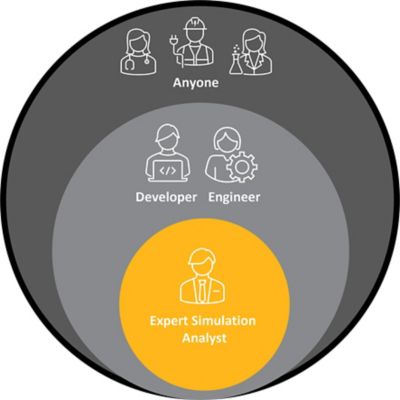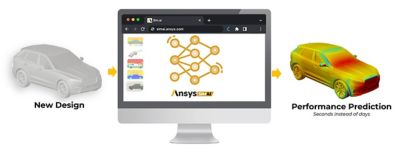ANSYS 部落格
March 6, 2024
AI 和模擬技術的交匯點
自 20 世紀中葉以來,科學家和工程師即借助模擬來進行測試、驗證並改進他們的設計。模擬軟體可針對每個模型產生合成資料 — 數以百萬計的計算結果全都是關於什麼可行,而什麼不可行的資料。如今,人工智慧 (AI) 將這些知識與即時洞察資訊相結合,填補了可能性所產生的差距,讓模擬功能變得比以往更加快速,而且也更容易使用。

人工智慧與模擬技術結合,可望為工程領域帶來真正的效益
結合 AI 和模擬技術有什麼好處?
設計和開發曾經受限於個別工程師手動執行模擬的速度和準確度。針對複雜系統進行塑模需要大量時間和專業知識,可能會導致進度延遲。如今,經過 AI 強化的模擬功能則可加速跨產業的設計和最佳化,尤其是十分注重準確度和效率的產業,例如汽車、航太、電子和材料科學等。
經 AI 強化的模擬包含以下優點:
- 速度更快:AI 可以分析過往的模擬,以快速識別複雜的模式,同時整合新資訊以審查資料中的關係。
- 使用上更簡單:AI 可透過使用者易用的網路型應用程式,讓非專業人員更容易使用模擬功能,同時也讓模擬技術更為大眾化。
- 範圍更全面:AI 模擬可整合多個模型,全面呈現複雜的系統。
- 持續加以改進:AI 和模擬技術所支援的迭代工程過程,讓工程師有更大的空間能改善設計。

AI 促成模擬技術大眾化,讓更多工程領域的受眾都能使用
訓練 AI 為何能實現快速預測
AI 要發揮作用,就需要聰明才智。資料模擬目前廣泛應用於跨主題 AI 訓練。
可從過去的模擬中擷取模擬資料,並根據興趣領域輸入 AI 系統。例如,如果 AI 正在學習積體電路,使用者就可以將電路板的效能結果載入到軟體中。
應用於 3D 物理的生成式 AI 可利用先前從物理式求解器所產生的模擬結果來訓練 AI 模型,提供更快的預測效能。與現有的降階模型 (ROM) 方法相比,資料導向方法的一個重要進步是工程師不再需要將幾何參數化以建立 AI 模型。因此,即使幾何結構不一致,也可以在設計變更時執行效能預測。
在模擬過程中,各種幾何的設計變數被輸入至 AI 後,幾乎立刻就能得到有關物理效能的預測。這使得設計迭代、探索和最佳化都變得更有效率,並且能觸及更廣泛的工程領域受衆,例如設計人員、系統工程師以及方法和工具專家。
傳統的物理式求解方法也可用於透過全擬真模擬來驗證所選定的最佳設計。
AI 和模擬技術的未來
AI 和模擬技術之間的互利關係將能持續提高工程師和設計人員的效率。隨著這兩項技術於各行各業和應用領域中變得更加普及,其在工程之外的廣泛應用將進一步加速人類的進步發展。隨著愈來愈多人透過結合這些功能強大的工具來發揮預測效力,各種可能性將會呈指數增長。
Ansys 產品系列中的最新產品即是 AI 與模擬技術結合的一個範例。Ansys SimAI 是一款機器學習平台,非常適合想要在設計階段快速探索和預測新概念效能的工程師使用。SimAI 能提供可靠且快速的結果,並可透過使用者易用的雲端原生應用程式存取。

Ansys SimAI 可利用過往資料來預測新設計的效能